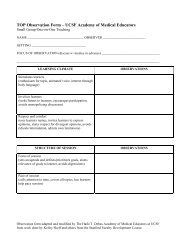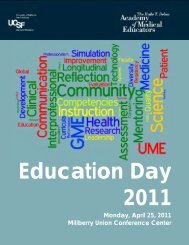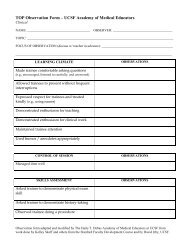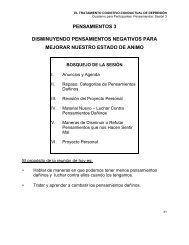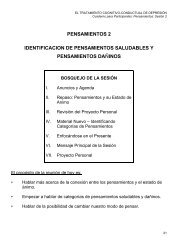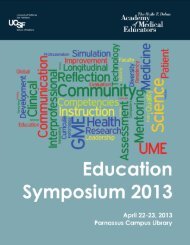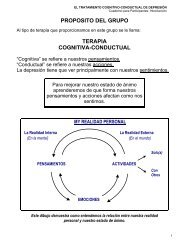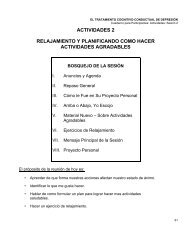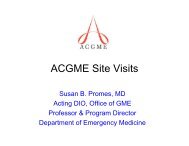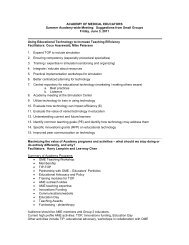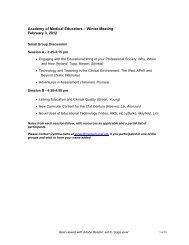Leadership Observation and Feedback Tool - UCSF School of ...
Leadership Observation and Feedback Tool - UCSF School of ...
Leadership Observation and Feedback Tool - UCSF School of ...
Create successful ePaper yourself
Turn your PDF publications into a flip-book with our unique Google optimized e-Paper software.
Part II – Project Narrative<br />
TITLE OF PROJECT:<br />
Title: <strong>Leadership</strong> <strong>Observation</strong> <strong>and</strong> <strong>Feedback</strong> <strong>Tool</strong> (LOFT)<br />
PRINCIPAL INVESTIGATOR:<br />
Read Pierce<br />
PROJECT SUMMARY/ABSTRACT (maximum 300 words)<br />
Clinical work environments provide numerous opportunities to work closely with multidisciplinary<br />
teams. Yet despite the increasing emphasis on preparing clinicians, <strong>and</strong> particularly physicians, to lead<br />
such teams, there remains a paucity <strong>of</strong> validated, generalizable assessment tools for evaluating<br />
leadership behaviors <strong>and</strong> providing feedback to learners in the health pr<strong>of</strong>essions. In 2009, we received<br />
an Innovations grant from the Academy <strong>of</strong> Medical Educators to establish a <strong>Leadership</strong> <strong>Observation</strong> <strong>and</strong><br />
<strong>Feedback</strong> <strong>Tool</strong> (LOFT). Based on an intensive review <strong>of</strong> existing leadership evaluation tools in the<br />
health sciences <strong>and</strong> business literatures, we undertook a careful adaptation <strong>of</strong> the best existing tools for<br />
team leadership in health care, <strong>and</strong> are currently preparing a pilot study with a preliminary LOFT that is<br />
qualitative in nature to help us identify a spectrum <strong>of</strong> leadership behaviors from novice to expert among<br />
physician trainees across 5, independent <strong>and</strong> previously validated leadership domains. We are<br />
conducting this pilot among residents in pediatrics <strong>and</strong> internal medicine during the 2010-2011<br />
academic year. Completion <strong>of</strong> our qualitative LOFT study will inform phase 2 <strong>of</strong> our project in the<br />
2011-2012 academic year: development <strong>of</strong> a second, quantitative LOFT that will undergo rigorous<br />
review by health care leadership experts <strong>and</strong> then iterative <strong>and</strong> broad utilization with residents <strong>and</strong><br />
critical care fellows in pediatrics <strong>and</strong> internal medicine. Data obtained through application <strong>of</strong> this<br />
quantitative LOFT will be analyzed to determine validity by looking for five sources <strong>of</strong> validity<br />
evidence as previously described by Downing. The subsequent development <strong>of</strong> a validated <strong>and</strong><br />
quantitative, scale-based tool for evaluating clinical leadership behaviors will ultimately allow<br />
application <strong>of</strong> the LOFT to a broad spectrum <strong>of</strong> health care pr<strong>of</strong>essionals at multiple levels <strong>of</strong> training,<br />
thereby supporting evaluation <strong>and</strong> improvement <strong>of</strong> leadership practices <strong>of</strong> those leading clinical teams.<br />
BACKGROUND AND SIGNIFICANCE<br />
In this era <strong>of</strong> rapidly increasing health care costs, worsening health disparities <strong>and</strong> unprecedented<br />
health care reform, it is increasingly recognized that the United States needs physician-leaders in<br />
all realms <strong>of</strong> practice. 3,4,5,7,18,19,27,28,29 Through emphasis on competence in communication <strong>and</strong><br />
interpersonal skills, the ACGME recognizes the well-described importance <strong>of</strong> teamwork <strong>and</strong><br />
team leadership, 1,11,16 <strong>and</strong> requires GME training programs to ensure that residents become<br />
competent in these domains. In addition, more attention is being paid to the need for clinical<br />
team leadership, especially in context <strong>of</strong> improving patient safety <strong>and</strong> reducing medical<br />
errors. 4,18,22 At <strong>UCSF</strong>, the novel Pathways to Discovery program aims to develop physicianleaders,<br />
but in most instances explicit incorporation <strong>of</strong> leadership training curricula is rare in<br />
medical education, both at <strong>UCSF</strong> <strong>and</strong> nationally. 8 Even though residents have many<br />
opportunities to serve as the leader <strong>of</strong> a team during training <strong>and</strong> to receive multisource feedback<br />
that could promote skills development, 24 formal education to further develop skills in team<br />
leadership is rarely provided, 8 despite evidence that multidisciplinary feedback <strong>and</strong> dedicated
Innovations Funding Application – Project Narrative Page 2<br />
leadership curricula can be an effective means for improving team leadership. 12,15 In order to<br />
formalize education in leadership skills <strong>and</strong> to ensure that the ACGME requirements regarding<br />
competence are met, adequate tools to assess leadership skills are needed.<br />
Assessment <strong>of</strong> team leadership is prevalent in the business literature <strong>and</strong> <strong>of</strong>ten based on project<br />
teams. In particular, the <strong>Leadership</strong> Practice Inventory (LPI) is a validated <strong>and</strong> reliable<br />
leadership assessment tool that has been used widely to provide multi-source feedback in varied<br />
settings. The LPI consists <strong>of</strong> 30 questions that map to 5 distinct domains: modeling <strong>of</strong> behavior,<br />
inspiring team members, challenging the process, enabling team members <strong>and</strong> recognizing<br />
others’ efforts. 26 We have used the LPI for several years to provide multi-source feedback for<br />
pediatric residents in the Pediatric <strong>Leadership</strong> for the Underserved (PLUS) program. Although<br />
overall satisfaction with this tool has been adequate, residents <strong>and</strong> evaluators have consistently<br />
commented that the LPI does not adequately address experiences on a clinical team <strong>and</strong> that<br />
some <strong>of</strong> the behavioral markers identified in the LPI are difficult to assess in the clinical setting.<br />
Recently, clinical team leadership tools have been developed for crisis resource management in<br />
“high stakes” clinical settings such as real <strong>and</strong> simulated resuscitations, operations <strong>and</strong><br />
emergencies. 9,13,14,17,21,23 These tools are all remarkably similar <strong>and</strong> assess overlapping leadership<br />
domains, including coordination, cooperation, situational awareness, <strong>and</strong> communication.<br />
Although some <strong>of</strong> these tools have undergone validity testing, 20,23 they are limited in their<br />
application to high-stakes, high-intensity clinical contexts that do not necessarily reflect daily<br />
work on most inpatient wards <strong>and</strong> in outpatient clinics.<br />
We are aware <strong>of</strong> only one published tool that was designed to measure leadership skills in non-crisis<br />
settings: Orl<strong>and</strong>er <strong>and</strong> colleagues have developed <strong>and</strong> validated a 7-item Resident <strong>Leadership</strong> Scale for<br />
internal medicine residents on inpatient services. 25 This tool is narrow in scope, as it is designed to<br />
measure leadership skills <strong>of</strong> senior internal medicine residents in an inpatient setting via evaluation by<br />
first-year residents. The Resident <strong>Leadership</strong> Scale would therefore need significant adaptation to be<br />
applicable in other settings or to incorporate feedback from more diverse, multidisciplinary evaluators.<br />
In addition, the report published on this tool does not provide any evidence for construct validity that is<br />
grounded in team leadership concepts identified in the literature.<br />
We postulate that for non-crisis clinical settings, where well defined teams work within a circumscribed<br />
setting under the longitudinal leadership <strong>of</strong> one clinician, the skill domains validated in the LPI<br />
instrument are highly relevant for capturing <strong>and</strong> evaluating leadership behaviors. However, based on our<br />
experience with the LPI, we feel that the instrument’s terminology is <strong>of</strong>ten ill-suited to clinical settings<br />
<strong>and</strong> requires too much time for completion to be accepted for routine use by health care pr<strong>of</strong>essionals.<br />
We therefore set out to develop, test <strong>and</strong> validate a comprehensive <strong>Leadership</strong> <strong>Observation</strong> <strong>and</strong><br />
<strong>Feedback</strong> <strong>Tool</strong> (LOFT) that is based on existing leadership frameworks; is applicable to a diverse set <strong>of</strong><br />
learners, practitioners <strong>and</strong> clinical settings; <strong>and</strong> can be used for multi-source feedback (see Preliminary<br />
Work section). With further refinement <strong>and</strong> validation, this tool has tremendous potential for application<br />
to a broad spectrum <strong>of</strong> health care pr<strong>of</strong>essionals at multiple levels <strong>of</strong> training, including medical<br />
students, physician trainees, faculty, <strong>and</strong> non-physician providers. Our ultimate goal is to improve the<br />
clinical leadership practices <strong>of</strong> those leading clinical teams, particularly physicians, regardless <strong>of</strong><br />
practice environment.
Innovations Funding Application – Project Narrative Page 3<br />
PRELIMINARY WORK<br />
With support from an AME Innovations Grant, we are currently implementing a LOFT for<br />
qualitative assessment <strong>of</strong> leadership skills. In order to identify <strong>and</strong> underst<strong>and</strong> existing leadership<br />
evaluation methods in clinical environments—including relevance to individual leadership skills<br />
development <strong>and</strong> limitations in generalizability—we performed an in-depth review <strong>of</strong> the<br />
literature on teamwork, team leadership, <strong>and</strong> physician trainee leadership in clinical work<br />
environments via PubMed <strong>and</strong> Business Source Complete searches. We subsequently<br />
summarized the essential elements <strong>of</strong> the TeamSTEPPS program, 9 the Mayo High Performance<br />
Teamwork Scale, 23 the Communication <strong>and</strong> Teamwork Skills (CATS) Assessment, 14 the<br />
Anaesthetists' Non-Technical Skills (ANTS), 13 <strong>and</strong> the Ottawa Crisis Resource Management<br />
Scale. 21 Due to limitations <strong>of</strong> these programs (as discussed above), <strong>and</strong> the strength <strong>of</strong> validity<br />
testing for the LPI, we then adapted the LPI tool to create a 5-domain instrument that is based on<br />
the essential domains <strong>of</strong> the LPI, but is shorter (10 questions rather than 30) <strong>and</strong> contains<br />
modified phrasing to ensure clinical applicability <strong>and</strong> incorporation <strong>of</strong> key, relevant concepts<br />
from the above programs identified in our literature search.<br />
For the development <strong>and</strong> first pilot phase <strong>of</strong> our project, we constructed the LOFT in such a way<br />
that the evaluator describes observed behaviors <strong>and</strong> gives suggestions for improvement, hence<br />
only providing qualitative data. Rationale for this approach was two-fold: 1) we want ultimately<br />
to create a quantitative rating tool that, like the LPI, is anchored to leadership behaviors ranging<br />
from novice to expert, but descriptions <strong>of</strong> such spectra <strong>of</strong> leadership behaviors does not presently<br />
exist in the medical education literature; 2) creation <strong>of</strong> a leadership behavior scale, whether<br />
numeric or descriptive (i.e., poor-to-excellent) would currently be arbitrary <strong>and</strong> subject to raters’<br />
tendency to give favorable scores, even for relatively poor performance. 6 We plan to use the first<br />
version <strong>of</strong> the LOFT in a group <strong>of</strong> pediatric <strong>and</strong> internal medicine residents to obtain qualitative<br />
data which will inform development <strong>of</strong> a quantitative tool with behavioral anchors. The first<br />
version <strong>of</strong> the LOFT tool <strong>and</strong> this project design was reviewed by ESCape, <strong>and</strong> we have obtained<br />
CHR approval for this project; enrollment <strong>of</strong> subjects will start early in 2011.<br />
SPECIFIC AIMS<br />
This grant application covers the second phase <strong>of</strong> development <strong>of</strong> a <strong>Leadership</strong> <strong>Observation</strong> <strong>and</strong><br />
<strong>Feedback</strong> <strong>Tool</strong> (LOFT), which involves the development, pilot <strong>and</strong> validation <strong>of</strong> the quantitative tool.<br />
Specific Aim 1: To create a quantitative tool for assessment <strong>of</strong> leadership skills based on qualitative<br />
data obtained during the 2010-2011 academic year from our first LOFT pilot.<br />
Specific Aim 2: To pilot <strong>and</strong> further develop the LOFT by trialing the quantitative tool with pediatric<br />
<strong>and</strong> internal medicine residents <strong>and</strong> critical care fellows <strong>and</strong> making iterative changes based on user<br />
feedback.<br />
Specific Aim 3: Use LOFT scores gathered in the trials to establish validity <strong>of</strong> the tool.
Innovations Funding Application – Project Narrative Page 4<br />
PROJECT DESIGN AND METHODS<br />
Specific Aim 1—Development <strong>of</strong> Quantitative <strong>Tool</strong>: In 2010-2011, we created a leadership behavior<br />
rubric covering 5 leadership practice domains, which are derived from the validated LPI <strong>and</strong> known to<br />
be independent <strong>of</strong> one another. Two broad, qualitative questions in each domain prompt LOFT users for<br />
written, open-ended descriptions <strong>of</strong> the leadership behaviors witnessed in physician-trainees who are<br />
leading clinical teams. In our current pilot, we are collecting a total <strong>of</strong> approximately 80 LOFTs<br />
providing qualitative assessment <strong>and</strong> feedback on leadership behaviors among residents in pediatrics <strong>and</strong><br />
internal medicine. Eight pediatric residents <strong>and</strong> 8 internal medicine residents on ward rotations are<br />
participating in the current pilot <strong>and</strong> identify 5 members <strong>of</strong> the interdisciplinary team they lead to<br />
complete the LOFT during the final week <strong>of</strong> their rotations. Participants receive instruction on principles<br />
<strong>of</strong> team leadership <strong>and</strong> on use <strong>of</strong> the LOFT prior to enrollment in the pilot. In this first phase, the LOFT<br />
is administered as a paper instrument to maximize completion rates. With our current funding, we will<br />
employ a research assistant to enter the data into qualitative analysis s<strong>of</strong>tware in the spring <strong>of</strong> 2011. We<br />
will then perform qualitative analysis <strong>of</strong> the LOFT responses until saturation has been reached to<br />
identify themes <strong>and</strong> delineate a spectrum <strong>of</strong> physician behaviors in each <strong>of</strong> the 5 leadership practice<br />
domains. This will inform creation <strong>of</strong> behavioral anchors on a scale from novice to expert.<br />
In phase 2 <strong>of</strong> LOFT development (2011-2012 academic year), we will use an expert panel made up <strong>of</strong> 8-<br />
10 local <strong>and</strong> national physician leaders to review the tool for completeness <strong>and</strong> accuracy in order to<br />
ensure content validity. Each expert independently will rate the perceived accuracy <strong>and</strong> relevance <strong>of</strong> the<br />
quantitative LOFT in two ways. First, experts will indicate the extent to which they agree that each<br />
LOFT domain is a useful component <strong>of</strong> a clinical team leadership assessment tool. Second, experts will<br />
be asked to rate how well the behavioral anchors capture the true novice-to-expert spectrum seen among<br />
individuals leading clinical teams. In a second iteration <strong>of</strong> the review, aggregate results <strong>of</strong> independent<br />
expert ratings will be shared with panel members so that each expert will know how the group <strong>of</strong> experts<br />
as a whole evaluated each domain <strong>and</strong> the behavioral anchors. Each expert will evaluate the LOFT by<br />
the same criteria, thereby allowing panel members to revise their ratings based on feedback from other<br />
experts. Domains <strong>and</strong> behavioral anchors will be included in the final version <strong>of</strong> the LOFT instrument if<br />
at least 80% <strong>of</strong> experts agree they are both relevant <strong>and</strong> adequately capture the novice-to-expert<br />
spectrum. All expert evaluations will be performed using a web based survey method (e.g. survey<br />
monkey).<br />
Specific Aim 2—Pilot the quantitative LOFT with pediatric <strong>and</strong> internal medicine residents <strong>and</strong><br />
critical care fellows: We will pilot the quantitative LOFT tool for 4-months among residents on<br />
general inpatient services <strong>and</strong> subspecialty fellows in critical care in pediatrics <strong>and</strong> internal medicine at<br />
M<strong>of</strong>fitt-Long Hospital. Similar to the qualitative LOFT pilot, all participants will be instructed on the<br />
use <strong>of</strong> the LOFT prior to participation, <strong>and</strong> each resident or fellow will be asked to select 5 members <strong>of</strong><br />
the multidisciplinary team to complete the LOFT. Given the number <strong>of</strong> pediatric <strong>and</strong> internal medicine<br />
residents <strong>and</strong> critical care fellows rotating at M<strong>of</strong>fitt-Long Hospital during the 4-month pilot, we<br />
anticipate that a total <strong>of</strong> 16 pediatric residents, 48 internal medicine residents, 6 pediatric critical care<br />
fellows <strong>and</strong> 4 adult critical care fellows will participate. The format <strong>of</strong> the quantitative tool will be<br />
paper-based, <strong>and</strong> we will elicit the help <strong>of</strong> a research assistant to enter data into an Excel spreadsheet.<br />
Data will then be imported into SPSS or other s<strong>of</strong>tware needed for further analysis as outlined in<br />
Specific Aim 3. We also will ask all participants to complete a brief on-line survey to assess satisfaction<br />
with the tool, including ease <strong>of</strong> use, applicability to the clinical work environment, <strong>and</strong> usefulness for<br />
giving or receiving feedback.
Innovations Funding Application – Project Narrative Page 5<br />
Specific Aim 3—Establish validity <strong>of</strong> the tool: For the following aim, we will obtain assistance from<br />
the Office <strong>of</strong> Medical Education (OME) for analysis. We will apply the now common unitary view <strong>of</strong><br />
validity, 2 <strong>and</strong> look for five sources <strong>of</strong> validity evidence as described by Steven Downing (content<br />
evidence, response process, internal structure, relationship to other variables <strong>and</strong> consequences). 10<br />
A. Content Evidence: A panel <strong>of</strong> experts will review the quantitative LOFT to ensure content validity<br />
as described in Specific Aim 1.<br />
B. Response Process: We will look for response process, essentially defined as data integrity, by<br />
reviewing completeness <strong>of</strong> the collected LOFTs. We will also survey participants as outlined in<br />
Specific Aim 2 to ensure that all questions in the tool are clear <strong>and</strong> unambiguous.<br />
C. Internal Structure: We will perform several statistical analyses to ensure reproducibility <strong>and</strong><br />
generalizability <strong>of</strong> the tool, including confirmatory factor analysis, known-groups comparisons <strong>and</strong><br />
generalizability study. For the latter, we plan a three facet generalizability study (G-study) using<br />
raters, items <strong>and</strong> occasions as facets. Based on this analysis, we will be able to determine the amount<br />
<strong>of</strong> score variance due to rater, item, occasion (<strong>and</strong> interactions) effects. We will then use this<br />
information to perform a decision study (D-study) to determine the number <strong>of</strong> raters <strong>and</strong> items (or<br />
items within sub-domains, depending on results <strong>of</strong> factor analysis) required to achieve a<br />
generalizability coefficient ≥ 0.8. We anticipate that we can use this approach, but because there is<br />
some unpredictability in how the LOFT will be used by different multidisciplinary evaluators, we<br />
will work with OME to decide on the best methodology as the project evolves.<br />
D. Relationship to other variables: Some <strong>of</strong> the participants in our pilot are routinely assessed with<br />
other leadership assessment tools. Pediatric residents in the PLUS program are routinely assessed<br />
with the LPI. 26 Pediatric intensive care fellows lead simulated resuscitations as part <strong>of</strong> their training<br />
<strong>and</strong> are assessed with the Ottawa Crisis Resource Management Global Rating Scale. 21 For these<br />
groups <strong>of</strong> participants, we will calculate correlation coefficients between scores on the LOFT <strong>and</strong><br />
either the LPI or the Ottawa GRS.<br />
E. Consequences: The consequential aspect <strong>of</strong> validity refers to the impact assessment scores have on<br />
the learner, <strong>and</strong> we will look for this by asking LOFT participants about the impact <strong>of</strong> the LOFT on<br />
their learning <strong>of</strong> leadership skills as part <strong>of</strong> the survey described under Specific Aim 2.<br />
We will obtain approval from the Committee for Human Research at <strong>UCSF</strong> for this project.<br />
PLAN FOR MEASUREMENT AND DOCUMENTATION OF PROJECT EFFICACY AND<br />
OUTCOME<br />
We will survey participants in the LOFT pilot using a Likert-based agree/disagree scale about ease <strong>of</strong><br />
use, time required to complete the LOFT, perceived validity <strong>of</strong> measuring clinical team leadership skills,<br />
<strong>and</strong> applicability <strong>of</strong> the LOFT in their particular clinical work environments. We will ask LOFT score<br />
recipients about their perceptions regarding the value <strong>of</strong> the LOFT for self-reflection on <strong>and</strong><br />
improvement <strong>of</strong> their team leadership skills. In particular, we will ask score recipients about how
Innovations Funding Application – Project Narrative Page 6<br />
accurately they believe the LOFT evaluation <strong>of</strong> their leadership behaviors along the novice-to-expert<br />
scale describes their self-perceptions <strong>of</strong> leadership competence. We also will elicit comments regarding<br />
potential improvements for the tool itself <strong>and</strong> use <strong>of</strong> the tool. Finally, we will use the procedures<br />
described in the specific aims to measure the content <strong>and</strong> construct validity <strong>of</strong> the tool <strong>and</strong> determine<br />
how to reliably use the tool.<br />
PLAN FOR CONTINUATION OF PROJECT AT THE END OF FUNDING CYCLE<br />
We have engaged residency program directors as well as current <strong>and</strong> future chief residents in pediatrics<br />
<strong>and</strong> internal medicine to assist with LOFT development <strong>and</strong> implementation. After completion <strong>of</strong> the<br />
project we plan to incorporate use <strong>of</strong> the LOFT in both internal medicine <strong>and</strong> pediatric residency <strong>and</strong><br />
critical care fellowship training at <strong>UCSF</strong>. We will describe the tool <strong>and</strong> the validity/reliability data in a<br />
manuscript, which we will submit for publication in a medical education journal. In addition, we plan to<br />
give presentations <strong>and</strong> workshops at local <strong>and</strong> national conferences to further disseminate the tool for<br />
use by other programs <strong>and</strong> institutions. Future projects will explore the utility <strong>of</strong> this tool in<br />
undergraduate medical education <strong>and</strong> a broader range <strong>of</strong> graduate medical education <strong>and</strong> other health<br />
care pr<strong>of</strong>essional schools.<br />
LETTERS OF SUPPORT<br />
1) Donna Ferriero, Interim Chair, Department <strong>of</strong> Pediatrics with Elena Fuentes, Chair,<br />
Pediatrics, SFGH, <strong>and</strong> Jeff Fineman, Chair, Pediatric Critical Care<br />
2) Dan West, Program Director, Department <strong>of</strong> Pediatrics<br />
3) Talmadge King, Chair, Department <strong>of</strong> Medicine<br />
4) Harry Holl<strong>and</strong>er, Program Director, Department <strong>of</strong> Medicine<br />
5) Christy Boscardin, Office <strong>of</strong> Medical Education<br />
REFERENCES<br />
1. Accreditation Council for Graduate Medical Education. Program Director Guide to the<br />
Common Program Requirements.<br />
http://www.acgme.org/acWebsite/navPages/nav_commonpr.asp<br />
2. American Educational Research Association, American Psychological Association,<br />
National Council on Measurement in Education. St<strong>and</strong>ards for Educational <strong>and</strong><br />
Psychological Testing. Washington, DC: American Educational Research Association,<br />
1999.<br />
3. Association <strong>of</strong> American Medical Colleges. The AAMC Project on the Clinical<br />
Education <strong>of</strong> Medical Students. Washington, DC; 2001.<br />
4. Berwick DM, Nolan TW. Physicians as leaders in improving health care: a new series in<br />
Annals <strong>of</strong> Internal Medicine. Ann Intern Med. 1998;128(4):289-292.
Innovations Funding Application – Project Narrative Page 7<br />
5. Buchler P, Martin D, Knaebel HP, Buchler MW. <strong>Leadership</strong> characteristics <strong>and</strong> business<br />
management in modern academic surgery. Langenbecks Arch Surg. 2006;391(2):149-<br />
156.<br />
6. Cacamese SM, Elnicki M, Speer AJ. Grade inflation <strong>and</strong> the internal medicine<br />
subinternship: a national survey <strong>of</strong> clerkship directors. Teach Learn Med. 2007<br />
Fall;19(4):343-6.<br />
7. Cheng TL, Szilagyi PG. <strong>Leadership</strong> in academic general pediatrics. J Pediatr. 2007<br />
May;150(5):451-2, 452.e1.<br />
8. Cooke M, Irby DM, O’Brien BC. Educating Physicians: A Call for Reform <strong>of</strong> Medical<br />
<strong>School</strong> <strong>and</strong> Residency. San Francisco: Jossey-Bass; 2010.<br />
9. Clancy CM, Tornberg DN. TeamSTEPPS: assuring optimal teamwork in clinical settings.<br />
Am J Med Qual. 2007 May-Jun;22(3):214-7.<br />
10. Downing SM. Validity: on meaningful interpretation <strong>of</strong> assessment data. Med Educ. 2003<br />
Sep;37(9):830-7.<br />
11. Druskat VU, Wolff SB. Building the emotional intelligence <strong>of</strong> groups. Harvard Business<br />
Review. 2001;79(3):80.<br />
12. Fitchner CG, Hardy D, Patel, M, et al. A Self-Assessment Program for Multidisciplinary<br />
Mental Health Teams. Psychiatric Services. 2001; 52:1352–1357, 2001.<br />
13. Fletcher G, Flin R, McGeorge P, Glavin R, Maran N, Patey R. Anaesthetists' Non-<br />
Technical Skills (ANTS): evaluation <strong>of</strong> a behavioural marker system. Br J Anaesth. 2003<br />
May;90(5):580-8.<br />
14. Frankel A, Gardner R, Maynard L, Kelly A. Using the Communication <strong>and</strong> Teamwork<br />
Skills (CATS) Assessment to measure health care team performance. Jt Comm J Qual<br />
Patient Saf. 2007 Sep;33(9):549-58.<br />
15. Goldstein AO, Calleson D, Bearman R, Steiner BD, Frasier PY, Slatt L. Teaching<br />
Advanced <strong>Leadership</strong> Skills in Community Service (ALSCS) to Medical Students.<br />
Academic Medicine. 2009;84(6):754-764.<br />
16. Goleman D. What makes a leader? Harvard Business Review. 1998;76(6):92-102.<br />
17. Guise JM, Deering SH, Kanki BG, Osterweil P, Li H, Mori M, Lowe NK. Validation <strong>of</strong> a<br />
tool to measure <strong>and</strong> promote clinical teamwork. Simul Healthc. 2008 Winter;3(4):217-23.<br />
18. Institute <strong>of</strong> Medicine: Committee on Quality <strong>of</strong> Health Care in America. Crossing the<br />
Quality Chasm: A New Health System for the 21st Century. Washington, DC: National<br />
Academy Press; 2001.
Innovations Funding Application – Project Narrative Page 8<br />
19. Kahn LH. State report - A prescription for change: The need for qualified physician<br />
leadership in public health. Health Aff. 2003;22(4):241-248.<br />
20. Kim J, Neilipovitz D, Cardinal P, Chiu M. A comparison <strong>of</strong> global rating scale <strong>and</strong><br />
checklist scores in the validation <strong>of</strong> an evaluation tool to assess performance in the<br />
resuscitation <strong>of</strong> critically ill patients during simulated emergencies (abbreviated as "CRM<br />
simulator study IB"). Simul Healthc. 2009 Spring;4(1):6-16.<br />
21. Kim J, Neilipovitz D, Cardinal P, Chiu M, Clinch J. A pilot study using high-fidelity<br />
simulation to formally evaluate performance in the resuscitation <strong>of</strong> critically ill patients:<br />
The University <strong>of</strong> Ottawa Critical Care Medicine, High-Fidelity Simulation, <strong>and</strong> Crisis<br />
Resource Management I Study. Crit Care Med. 2006 Aug;34(8):2167-74.<br />
22. Lee TH. Turning Doctors into Leaders. Harv Bus Rev. 2010 Apr;88(4):50-8<br />
23. Malec JF, Torsher LC, Dunn WF, Wiegmann DA, Arnold JJ, Brown DA, Phatak V. The<br />
Mayo high performance teamwork scale: reliability <strong>and</strong> validity for evaluating key crew<br />
resource management skills. Simul Healthc. 2007 Spring;2(1):4-10.<br />
24. Miller A, Archer J. Impact <strong>of</strong> workplace based assessment on doctors' education <strong>and</strong><br />
performance: a systematic review. BMJ. 2010 Sep 24;341:c5064.<br />
25. Orl<strong>and</strong>er JD, Wipf JE, Lew RA. Development <strong>of</strong> a tool to assess the team leadership<br />
skills <strong>of</strong> medical residents. Med Educ Online. 2006;11:27.<br />
26. Posner, B. <strong>Leadership</strong> Practices Inventory Data Analysis. Retrieved on Oct 20, 2009<br />
from: http://media.wiley.com/assets/2034/63/LPIAnalysisAug2009.pdf.<br />
27. Schwartz RW, Tumblin TF. The power <strong>of</strong> servant leadership to transform health care<br />
organizations for the 21st-century economy. Arch Surg. 2002;137(12):1419-1427;<br />
discussion 1427.<br />
28. Solyom AE. Viewpoint: Improving the health <strong>of</strong> the public requires changes in medical<br />
education. Acad Med. 2005;80(12):1089-1093.<br />
29. Williams SJ. What skills do physician leaders need now <strong>and</strong> in the future? Physician<br />
Exec. 2001;27(3):46-48.



